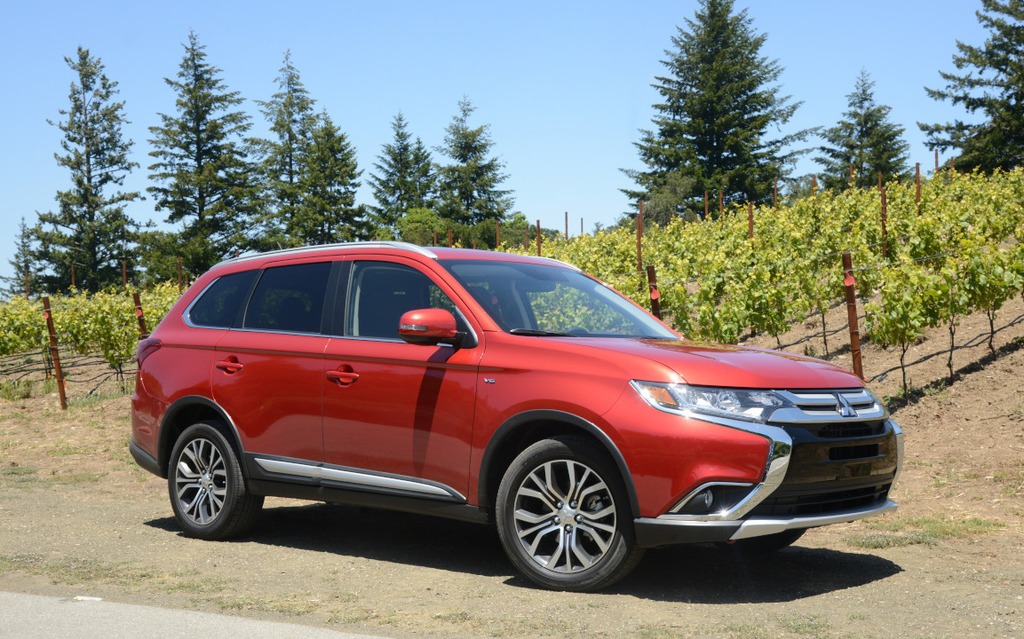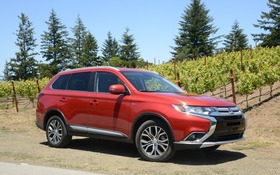2016 Mitsubishi Outlander: A Very Decent Proposal

| Strong points |
|
|---|---|
| Weak points |
|
In 2014, the Outlander got its first serious update since 2010. The body was totally redesigned and they added a 2.4-litre four-cylinder engine to the 3.0-litre V6 already on offer. The vehicle’s technical sophistication was stepped up and its safety systems were enhanced. And the new generation finally offered a smooth ride.
You’d think that a jazzed up model like this would enjoy a certain amount of success, but it never materialized, at least not to the extent that Mitsubishi had hoped for. And the reason is as clear as day: the unusual front treatment scared off buyers. It was so obvious that they updated its appearance just a year later, which is almost unheard of in such a short time.
- Also: 2016 Mitsubishi Outlander – Canadians Prefer the V6
- Also: 2016 Mitsubishi Outlander PHEV: A Facelift And New Tech
But Mitsubishi knew that touching up the grille and fenders, and adding new wheels on the GT wasn’t going to be enough. They had to come up with something more substantial.
No more weird stuff!
For years, Mitsubishi designers came up with vehicle exteriors that were just plain weird. This time, however, they stepped into line and designed something less controversial, in keeping with the public’s preferences.
The new grille features two chrome bars running over a black section with slits to let air into the engine compartment. LEDs have been added to the daytime running lights and the GT’s headlights. Less pronounced changes were made to the rear of the vehicle, where LEDs were also added.
Inside the cabin, various details were updated and the overall quality of materials was enhanced. The information display now features simplified controls and an auto-dimming rearview mirror is available on some models. Note that certain equipment configurations allow you to add a third row of seats, but given its size, this row should only be considered for occasional use.
In short, the new gen is more elegant and refined than before.
Tried and true mechanical components
Since the Outlander’s platform wasn’t a problem in the 2014, it remains unchanged in the 2016 version. That said, all the mechanical components have been updated and improved.
For example, the 166-horsepower 2.4-litre four-cylinder engine is now paired with a more effective CVT, the only transmission available for this engine. However, this year, there’s a 26% decrease in transmission torque loss, which results in livelier acceleration and pick-up as well as better fuel efficiency.
The 3.0-litre V6 is still available, but it can only be mated to a six-speed automatic gearbox with wheel-mounted paddle shifters. A new catalytic converter steals away three ponies, so the total output goes from 227 to 224 horsepower. It’s the only V6 in the category and can tow up to 3,500 lbs—an important point in its favour for many buyers. High-octane fuel is recommended for it.
One of the 2015 Outlander’s strengths was the all-wheel drive system available on most trims. For 2016, just the base trim comes with front-wheel drive, and all the others come with the All Wheel Control (AWC) system, which includes three different modes:
- Eco mode: Most of the time, just the front wheels are powered, but some torque is transmitted to the rear wheels if the vehicle loses traction.
- Auto mode: Torque is distributed proportionally to the wheels with the best grip.
- Lock mode: Torque is distributed to all four wheels equally.
- Snow mode: The name says it all for this fourth mode, which is available on the trims with Super All Wheel Control (S-AWC).
Mitsubishi also made a major effort to make the cabin quieter and the ride smoother. The suspension has been reinforced and the springs are now stiffer.
More consistent
Since the 2016 Outlander features the same engines and platform as before, its ride isn’t dramatically different than in the past. However, the platform is a little more rigid, the soundproofing has been improved and the interior has been updated, all of which makes for a more pleasant vehicle whose quality is consistent across the board. One thing we would have liked to see was direct fuel injection on the four-cylinder mill, as this would have improved its fuel economy and output.
When we drove the Outlander on the test circuit, we found that the 166 horses were up to task. Even on very winding roads, the V6 never seemed too heavy. If you’re looking for an SUV with a smooth engine and good towing capacity, you may want to consider this option.
The test circuit devised by Mitsubishi included lots of tight corners, many of which were in a row. Despite the fact that the Outlander’s centre of gravity is higher than a sedan’s, it’s easy to handle and I never had to correct its trajectory when coming out of corners. The brakes didn’t overheat on downhill runs either.
However, we noticed that, on one of the test models, the third-row headrests seriously obstructed rear visibility. Not to mention the fact that, when raised, the third row takes up a lot of the available cargo space.
Mitsubishi’s efforts to improve the Outlander have not been in vain, though the changes fall short of spectacular for the lightly updated mechanical parts. When you combine the enhanced silhouette with all the small tweaks and improvements, you get a decidedly more consistent and competitive Outlander. And let’s not forget that even though the all-wheel drive system hasn’t changed, it remains one of the best on the market.
This time, Mitsubishi has more than just a generous warranty up its sleeve to attract buyers.











